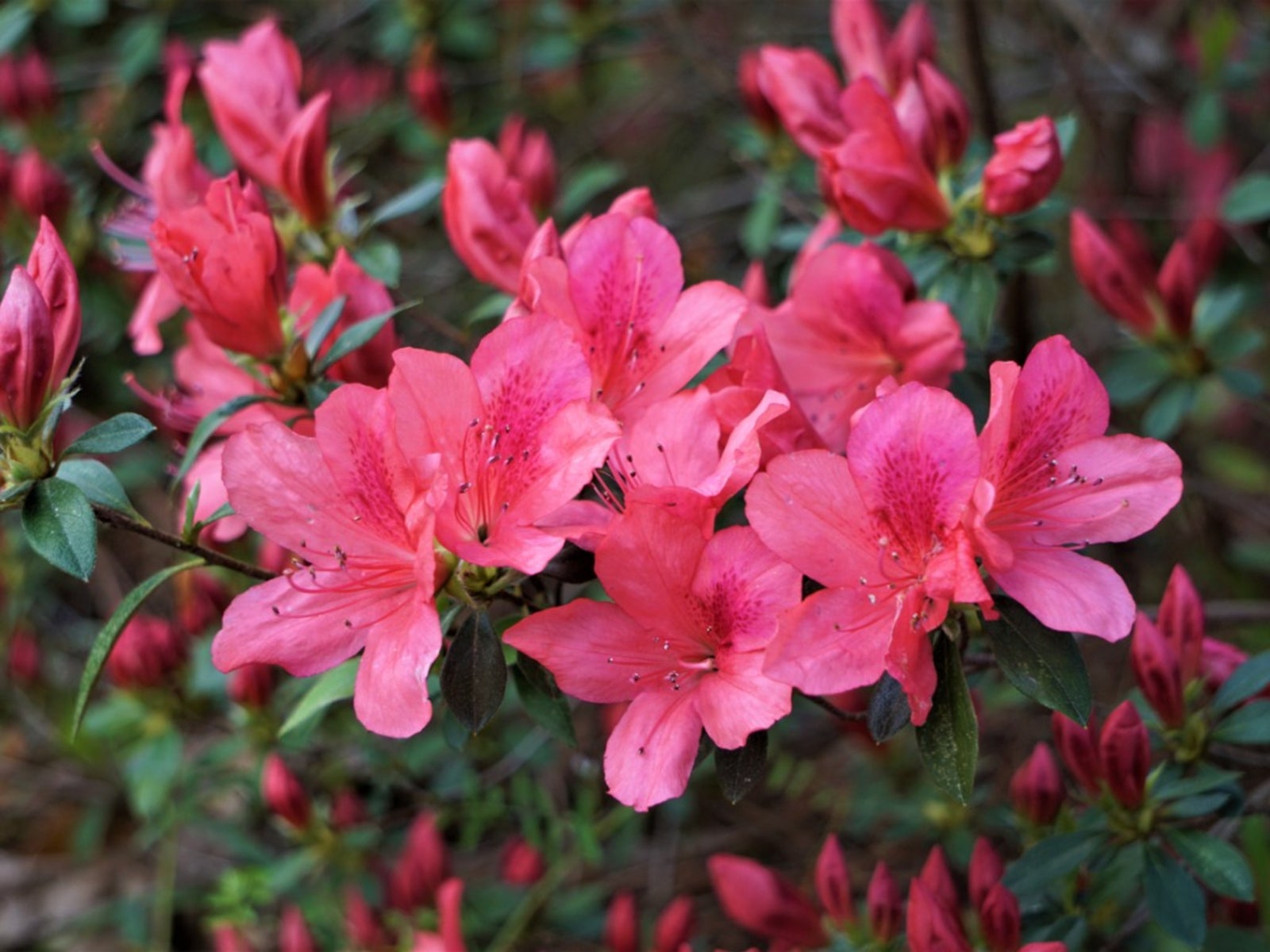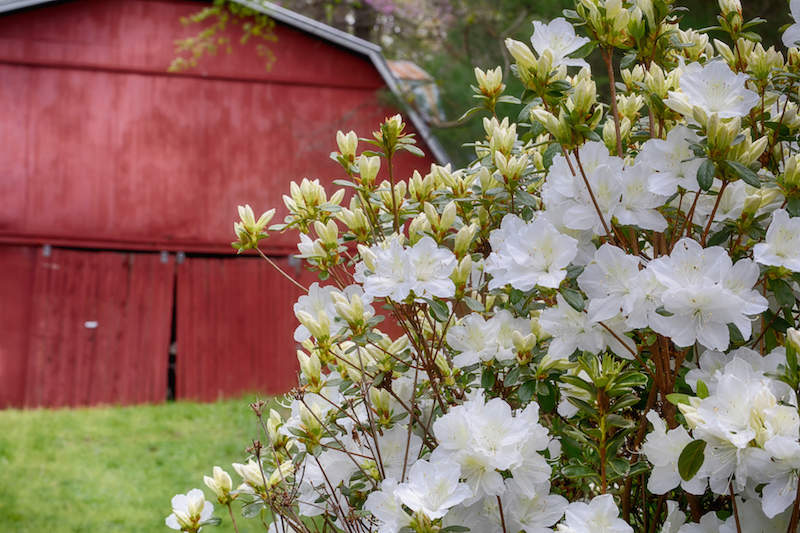Understanding Azalea Planting Seasons
Azaleas are a popular choice for gardeners due to their vibrant flowers and relatively low maintenance requirements. However, to ensure optimal growth and blooming, it’s essential to plant azaleas at the right time. The ideal planting season for azaleas varies depending on the climate, soil temperature, and frost patterns in your area.
In general, azaleas thrive in temperatures between 40°F and 70°F (4°C and 21°C). Planting azaleas during this temperature range allows for healthy root development and promotes robust growth. In regions with mild winters, azaleas can be planted in the fall or early spring, while areas with harsh winters should plant azaleas in the spring after the last frost.
Soil temperature is another critical factor to consider when planting azaleas. Azaleas prefer soil temperatures between 50°F and 65°F (10°C and 18°C). Planting azaleas when the soil is too cold can lead to slow growth and increased susceptibility to disease.
Frost is also a significant concern when planting azaleas. Young azalea plants are particularly vulnerable to frost damage, which can cause significant damage or even kill the plant. In areas with frequent frosts, it’s best to plant azaleas in the spring after the last frost or in the fall, about 6-8 weeks before the first frost.
By understanding the specific planting seasons and conditions in your area, you can ensure that your azaleas receive the best possible start in life. This knowledge will help you determine when to plant azaleas in your region, setting them up for success and a vibrant display of flowers.
How to Choose the Perfect Time to Plant Azaleas in Your Region
Determining the best time to plant azaleas in your region requires consideration of several factors, including USDA Hardiness Zones, average frost dates, and soil conditions. By understanding these factors, you can ensure that your azaleas are planted at the optimal time for success.
USDA Hardiness Zones are a crucial factor in determining when to plant azaleas. Azaleas thrive in zones 5-9, with some varieties tolerating warmer or cooler temperatures. If you live in an area with a moderate climate, you can plant azaleas in the spring or fall. However, if you live in an area with harsh winters or hot summers, you may need to adjust your planting schedule accordingly.
Average frost dates are another essential factor to consider when planting azaleas. Azaleas are sensitive to frost, and planting them too early can result in damage or death. Check the average frost dates for your area and plant azaleas after the last frost date in the spring or before the first frost date in the fall.
Soil conditions also play a significant role in determining when to plant azaleas. Azaleas prefer well-draining, acidic soil with a pH between 5.5 and 6.5. If your soil is heavy clay or sandy, you may need to amend it before planting azaleas. Additionally, if your soil is prone to waterlogging, you may need to plant azaleas in raised beds or containers.
By considering these factors, you can determine the best time to plant azaleas in your region. For example, if you live in the southeastern United States, you can plant azaleas in the fall, about 6-8 weeks before the first frost. In the northeastern United States, you can plant azaleas in the spring, after the last frost date.
When deciding when to plant azaleas, it’s also essential to consider the specific variety you are planting. Some azalea varieties, such as the ‘Encore’ series, are bred to be more heat-tolerant and can be planted in warmer climates. Others, such as the ‘Girard’ series, are more cold-hardy and can be planted in cooler climates.
By taking the time to research and understand the specific needs of your azalea variety, you can ensure that you plant them at the optimal time for success. This will help you achieve the best possible results and enjoy the beautiful blooms of your azaleas for years to come.
Spring vs. Fall: Which is the Best Time to Plant Azaleas?
When it comes to planting azaleas, the timing can be a bit tricky. While azaleas can be planted in both the spring and fall, each season has its pros and cons. Understanding the advantages and disadvantages of planting azaleas in the spring versus the fall can help you make an informed decision and ensure the best possible results.
Planting azaleas in the spring can be beneficial for several reasons. For one, the weather is typically mild, with temperatures gradually warming up after a cold winter. This allows azaleas to establish themselves before the heat of summer sets in. Additionally, spring planting gives azaleas a head start on the growing season, allowing them to produce flowers and foliage before the summer months.
However, spring planting also has its drawbacks. For one, the soil may still be quite cool, which can slow down the growth of azaleas. Additionally, spring is a time of high pest and disease activity, which can put newly planted azaleas at risk.
On the other hand, planting azaleas in the fall can be a great option for several reasons. For one, the weather is typically cooler, with temperatures gradually cooling down after a hot summer. This allows azaleas to establish themselves before the cold winter months set in. Additionally, fall planting gives azaleas a chance to establish a strong root system before the winter, which can help them survive the cold temperatures.
However, fall planting also has its drawbacks. For one, the days are getting shorter, which can limit the amount of time azaleas have to establish themselves before the winter. Additionally, fall is a time of high wind and rain activity, which can put newly planted azaleas at risk.
Ultimately, the best time to plant azaleas depends on your specific climate and region. If you live in an area with mild winters, spring planting may be the best option. However, if you live in an area with harsh winters, fall planting may be a better choice. By understanding the pros and cons of each season, you can make an informed decision and ensure the best possible results for your azaleas.
It’s also worth noting that some azalea varieties are better suited to spring or fall planting. For example, the ‘Encore’ series of azaleas is bred to be more heat-tolerant and can be planted in the spring. On the other hand, the ‘Girard’ series of azaleas is more cold-hardy and can be planted in the fall.
By taking the time to research and understand the specific needs of your azalea variety, you can ensure that you plant them at the optimal time for success. This will help you achieve the best possible results and enjoy the beautiful blooms of your azaleas for years to come.
Azalea Planting Tips for Specific Regions
Azaleas can be grown in a variety of regions, but the specific planting requirements may vary depending on the climate and soil conditions. Here are some region-specific tips for planting azaleas:
**Mild Winter Regions:** In areas with mild winters, such as the southeastern United States, azaleas can be planted in the fall or early spring. The soil should be well-draining and acidic, with a pH between 5.5 and 6.5. Azaleas in these regions should be planted in a location that receives partial shade to full sun.
**Hot Summer Regions:** In areas with hot summers, such as the southwestern United States, azaleas should be planted in the fall or early spring to avoid the heat. The soil should be well-draining and acidic, with a pH between 5.5 and 6.5. Azaleas in these regions should be planted in a location that receives partial shade to full sun.
**High Altitude Regions:** In areas with high altitudes, such as the Rocky Mountains, azaleas should be planted in the spring after the last frost. The soil should be well-draining and acidic, with a pH between 5.5 and 6.5. Azaleas in these regions should be planted in a location that receives partial shade to full sun.
**Coastal Regions:** In areas with high winds and salt spray, such as coastal regions, azaleas should be planted in a location that provides some protection from the wind and salt. The soil should be well-draining and acidic, with a pH between 5.5 and 6.5. Azaleas in these regions should be planted in the fall or early spring.
**Northern Regions:** In areas with cold winters, such as the northeastern United States, azaleas should be planted in the spring after the last frost. The soil should be well-draining and acidic, with a pH between 5.5 and 6.5. Azaleas in these regions should be planted in a location that receives partial shade to full sun.
By following these region-specific tips, you can ensure that your azaleas are planted at the right time and in the right location for optimal growth and success.
Preparing the Soil for Azalea Planting
Before planting azaleas, it’s essential to prepare the soil to ensure optimal growth and success. Azaleas prefer well-draining, acidic soil with a pH between 5.5 and 6.5. Here are some tips to help you prepare the soil for azalea planting:
**Testing pH Levels:** The first step in preparing the soil for azalea planting is to test the pH levels. You can purchase a soil testing kit or send a sample to a laboratory for analysis. If the pH levels are too high or too low, you can adjust them by adding lime or sulfur.
**Adding Organic Matter:** Azaleas thrive in soil with high levels of organic matter. You can add compost, peat moss, or well-rotted manure to the soil to improve its structure and fertility. Mix the organic matter into the top 6-8 inches of soil to create a well-draining and fertile growing medium.
**Removing Debris:** Remove any debris, such as rocks, weeds, and dead plant material, from the soil before planting azaleas. This will help prevent competition for water and nutrients and reduce the risk of disease and pests.
**Improving Soil Structure:** Azaleas prefer well-draining soil with a loose, open structure. You can improve the soil structure by adding perlite, vermiculite, or sand. These materials will help to break up clay soils and improve drainage.
**Fertilizing:** Azaleas require regular fertilization to promote healthy growth and flowering. Use a balanced, acidic fertilizer (such as 10-10-10 NPK) and follow the manufacturer’s instructions for application rates and timing.
By following these tips, you can create a well-prepared soil environment for your azaleas to thrive. Remember to plant azaleas at the right time for your region, and provide them with the necessary care and maintenance to ensure optimal growth and success.
Planting Azaleas in Containers: A Guide
Planting azaleas in containers is a great way to enjoy these beautiful flowers in small spaces or in areas with poor soil. Here’s a step-by-step guide on how to plant azaleas in containers:
**Choosing the Right Potting Mix:** Azaleas prefer well-draining, acidic potting mix with a pH between 5.5 and 6.5. Look for a potting mix that is specifically designed for azaleas and rhododendrons.
**Selecting the Right Container:** Choose a container that is at least 6-8 inches deep and has good drainage holes. Azaleas prefer to be slightly root-bound, so a smaller container is better than a large one.
**Planting the Azalea:** Plant the azalea in the container, making sure the root ball is level with the soil surface. Add a layer of potting mix around the root ball, and gently firm it in place.
**Watering and Fertilizing:** Water the azalea regularly, but make sure the potting mix is not too wet or dry. Fertilize the azalea with a balanced, acidic fertilizer (such as 10-10-10 NPK) during the growing season.
**Providing the Right Conditions:** Azaleas prefer bright, indirect light and cool temperatures. Place the container in a location that receives morning sun and afternoon shade, and keep the temperature between 60-70°F (15-21°C).
**Pruning and Repotting:** Prune the azalea regularly to maintain its shape and promote healthy growth. Repot the azalea every 2-3 years in the spring, using a slightly larger container and fresh potting mix.
By following these steps, you can successfully plant and care for azaleas in containers. Remember to plant azaleas at the right time for your region, and provide them with the necessary care and maintenance to ensure optimal growth and success.
Common Mistakes to Avoid When Planting Azaleas
When planting azaleas, it’s essential to avoid common mistakes that can impact their growth and survival. Here are some mistakes to avoid:
**Planting Too Deeply:** Azaleas should be planted at the same depth as they were in the nursery, or slightly higher. Planting too deeply can cause the roots to rot and the plant to decline.
**Not Providing Enough Sunlight:** Azaleas require bright, indirect light to thrive. Planting them in a location with too little sunlight can cause weak and spindly growth.
**Neglecting to Water Properly:** Azaleas require consistent moisture, especially during the first year after planting. Neglecting to water properly can cause the plant to decline and become susceptible to disease.
**Not Mulching:** Mulching around the base of the azalea can help retain moisture, suppress weeds, and regulate soil temperature. Not mulching can cause the soil to dry out and the plant to suffer.
**Not Fertilizing:** Azaleas require regular fertilization to promote healthy growth and flowering. Not fertilizing can cause the plant to decline and become susceptible to disease.
**Not Pruning:** Pruning azaleas regularly can help maintain their shape, promote healthy growth, and encourage flowering. Not pruning can cause the plant to become leggy and unproductive.
**Not Monitoring for Pests and Diseases:** Azaleas are susceptible to pests and diseases, such as lace bugs, spider mites, and root rot. Not monitoring for these problems can cause the plant to decline and become susceptible to further damage.
By avoiding these common mistakes, you can help ensure the success of your azalea planting and enjoy the beautiful blooms of these stunning flowers.
Post-Planting Care for Azaleas: Ensuring Success
After planting azaleas, it’s essential to provide them with the right care to ensure they thrive. Here are some tips on post-planting care for azaleas:
**Watering:** Azaleas require consistent moisture, especially during the first year after planting. Water them regularly, but make sure the soil isn’t too wet or dry. Check the soil moisture by inserting your finger into the soil up to the first knuckle. If the soil feels dry, it’s time to water.
**Fertilizing:** Azaleas require regular fertilization to promote healthy growth and flowering. Use a balanced, acidic fertilizer (such as 10-10-10 NPK) and follow the manufacturer’s instructions for application rates and timing.
**Pruning:** Prune azaleas regularly to maintain their shape, promote healthy growth, and encourage flowering. Prune them immediately after they finish blooming, removing any dead or damaged branches.
**Monitoring for Pests and Diseases:** Azaleas are susceptible to pests and diseases, such as lace bugs, spider mites, and root rot. Monitor them regularly for signs of infestation or infection, and take action promptly if you notice any problems.
**Mulching:** Mulch around the base of the azalea to retain moisture, suppress weeds, and regulate soil temperature. Use a thin layer of organic mulch, such as wood chips or bark, and keep it a few inches away from the plant’s stem.
**Deadheading:** Remove spent flowers (called deadheading) to encourage the azalea to produce more blooms. Cut off the flower stem just above a leaf node, and the plant will produce a new flower stem.
By following these post-planting care tips, you can help ensure the success of your azalea planting and enjoy the beautiful blooms of these stunning flowers.









